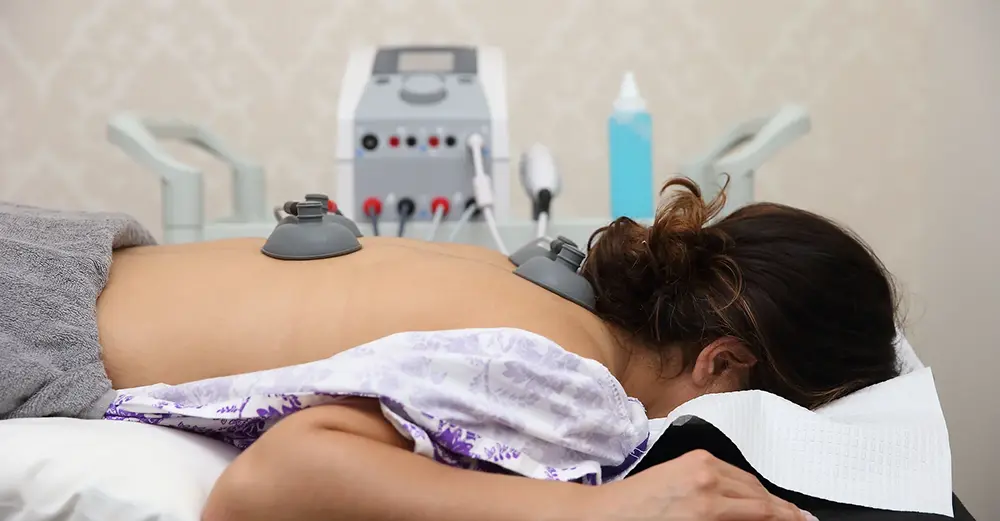Menu
Modality is a physical agent (electrical, thermal or mechanical) that produces a specific therapeutic response through a physiological change.

Therapeutic ultrasound is a modality that has been used by physiotherapists since the 1940s. Ultrasound is applied using the head of an ultrasound probe that is placed in direct contact with your skin via a transmission coupling gel.
The benefits of therapeutic ultrasound are as follow:
Increasing healing rates
Relaxation of soft tissue
Increasing blood flow to a localised area
Promote/facilitate scar tissue breakdown.
The ultrasound head sends soundwaves through soft tissue which allows the tissue to be heated thus creating increased blood flow in deeper regions of the body. Increases in local blood flow have shown to help reduce localised swelling and chronic inflammation. The intensity can be adjusted according to the desired result, from breaking down scar tissue to aiding healing of harder to reach structures such as tendon and ligaments.
Another use of the ultrasound is to achieve phonophoresis, a non-invasive way of administering medication to tissues below the skin. The ultrasound enables greater and deeper absorption off the cream based medication. Cortisone, mostly used to reduce inflammation, is commonly used to promote healing of tendons (of muscles with tendonitis) or assist with reducing joint swelling
Within the head of the ultrasound probe, vibration is created through crystals which in turn cause a piezoelectric effect. The ultrasound waves pass through the skin and soft tissue causing a local heating effect to promote healing (as mentioned above).
Shockwave Therapy or Radial Shockwave Therapy provides treatments to patients suffering from a range of chronic conditions that are notoriously difficult to resolve.
Originally it was developed in the treatment of kidney stones as an alternative to invasive surgical procedures. Along with noting differences in the size of the stones, patients had reported improvement of chronic musculoskeletal conditions in the area of treatment and thus further research and development was placed into it's use.
High pressure acoustic shockwaves are produced and passed through the skin to begin tissue repair and stimulate pain relief. With the ability to change the range and depth of the shockwaves, therapists are able to penetrate deeper tissues that other modalities cannot reach.
Transcutaneous electrical nerve stimulation (TENS) | For the use of pain, electrodes are placed over the affected area. Once activated the current stimulates the sensory nerves and desensitises them to the stimulant of pain. This causes a gentle tingling sensation from electrode to electrode. Commonly TENS machines are used for home use and run off normal batteries.
Interferential current (IFC) | Considered a deeper form of TENS, IFC uses a higher frequency which allows the waveform to penetrate deeper tissue. As well as pain relief, this more powerful therapy also assists with improving circulation, reducing oedema and muscle spasm.
Percutaneous electrical nerve stimulation (PENS) | An electrical stimulus is applied to an acupuncture needle. This allows more direct contact to the affected tissue, thus having greater effect for pain relief than the more superficial methods.
Electrical muscle stimulation (EMS) | The electrical current is used directly on the muscles to create a contraction to encourage muscle building. This allows substantially weakened muscles or over-dominated muscles to regain functional strength.
Multiple recent clinical trials have shown shockwave therapy is highly effective at treating the following conditions:
Plantar fasciitis/heel spur
Shoulder tendinopathies +/- calcification
Tennis elbow (lateral epicondylitis)
Achilies tendinopathy
Patella tendinopathy
Impressive results have been seen for patients with chronic/difficult to resolve injuries when the shockwave is used in conjunction with other modalities of treatment.


A range of electrotherapy devices that use an electrical stimulus to reduce pain, improve circulation, repair & strengthen muscles and promote bone growth.
Although the main concept is used for the different types of electrotherapy, the devices vary in frequency, effect, waveforms and current. Thus creating different effects for muscle, bones and soft tissue. Here are some of the most commonly used types of electrotherapy:
Transcutaneous electrical nerve stimulation (TENS) | For the use of pain, electrodes are placed over the affected area. Once activated the current stimulates the sensory nerves and desensitises them to the stimulant of pain. This causes a gentle tingling sensation from electrode to electrode. Commonly TENS machines are used for home use and run off normal batteries.
Interferential current (IFC) | Considered a deeper form of TENS, IFC uses a higher frequency which allows the waveform to penetrate deeper tissue. As well as pain relief, this more powerful therapy also assists with improving circulation, reducing oedema and muscle spasm.
Percutaneous electrical nerve stimulation (PENS) | An electrical stimulus is applied to an acupuncture needle. This allows more direct contact to the affected tissue, thus having greater effect for pain relief than the more superficial methods.
Electrical muscle stimulation (EMS) | The electrical current is used directly on the muscles to create a contraction to encourage muscle building. This allows substantially weakened muscles or over-dominated muscles to regain functional strength.
Cold compression therapy combines the benefits of cold therapy and compression therapy to provide optimal results for pain and swelling relief. Studies have shown that people who use cold therapy and compression therapy together as opposed to just one of those therapies alone recover from their injuries significantly faster. The many benefits of cold compression therapy include reducing pain, swelling, and edema, while promoting faster healing and muscle recovery, and stimulating blood flow.
PowerPlay combines the benefits of a cold therapy machine (or cold therapy unit) and a compression machine to deliver intermittent compression therapy – meaning the compression pump inflates the wrap to the desired pressure, holds for 10 seconds, releases, then inflates again. Intermittent compression has been proven to be more effective than static compression because it moves the blood more effectively, helping push the swelling out of the system. PowerPlay also offers cold therapy through frozen gel packs or ice bags, which have been proven to reduce pain.
Cold and compression therapy can be applied to a variety of situations including post-surgical rehabilitation (such as MCL and ACL surgery recovery), injuries such as sprains, fractures, and tears, as well as pain and swelling. Most athletes are familiar with the RICE method for recovering from injuries, which stands for Rest, Ice, Compression, and Elevation. While we leave rest and elevation up to you, PowerPlay uses advanced technology to make your ice and compression more effective.
Compression alone is shown to be effective in reducing swelling and edema. Active compression, which compresses intermittently, pushes that swelling out of the injured site and to the body’s core so it can be disposed of through the lymphatic system. This type of compression also aids in enhancing the body’s blood flow, which helps deliver more oxygen to the injured area.
Cold therapy has also been proven to reduce pain and swelling, making your recovery faster and more comfortable. Doctors have recommended 20 minutes of cold therapy at a time, alternating between cold and warm or room temperature. We recommend using your PowerPlay gel pack after it has been initially frozen for one hour, then placing it on your affected area for 20 minutes, and returning it to the freezer while your body rests from the ice.
Contrary to the assumption of “the colder, the better,” therapeutic cold has been shown to be between 40 and 50 degrees Fahrenheit. Studies find that when active compression is coupled with cold therapy, it results in increased blood flow, and decreased swelling, edema, and muscle spasms. Applying ice or cold to your injury also makes recovery less painful and more comfortable.
These benefits of cold compression therapy amount to a faster and more pleasant recovery. This therapy can be applied to those suffering from minor joint pain, to major surgery rehabilitation (such as ACL surgery recovery) and anything in between. You can also benefit from a compression and cold therapy system for muscle recovery after training. Applying cold and compression to overworked, aching muscles will pump blood and oxygen through the area, and bring down swelling and fluids so that you can get back on your feet faster and be ready for your next event.

We work holistically, asessing the whole body and delivering treatments that target not just the ‘problem area’, but all associated joints, muscles and nerves.
For your convenience, we’ve put together a list of some common questions and answers. Perhaps you have the same question that was on somebody else’s mind.
Can’t find what you’re looking for? Drop us a line and our team of professionals will be happy to find the answer for you.
You should bring with you:
For treatment under work cover you must bring in a work cover certificate(from your GP) and insurance details if you have them eg. claim number,name of insurance company, and case manager.
The duration of the initial consultation is approximately 60 minutes which includes 10 to 15 minutes for the diagnosis and 45 to 60 minutes for the treatment.The duration of a subsequent consultation is approximately 45 to 60 minutes.
The fees for our services are:
We are located at Unit 4, 99 Crown Street, Darlinghurst, a few doors down from the City Gym. If you’re not within the area, you can catch the train to Museum or St James train station and take a short walk (roughly 11 minutes) up to Crown street. For more details on how to get to Kinesis by City Gym, please visit https://www.whereis.com

Lorem ipsum dolor sit amet, consectetur adipiscing elit. Cras auctor sem et felis dapibus, consectetur lacinia mi suscipit. Sed sit amet nisl pulvinar, dignissim quam eu, vestibulum metus. Nam quis massa at libero aliquam pharetra ac nec augue. Integer ac est massa. Sed sit amet arcu bibendum, semper ex sit amet, dictum massa. Class aptent taciti sociosqu ad litora torquent per conubia nostra, per inceptos himenaeos.
Quisque euismod bibendum sodales. Phasellus nec maximus sapien. Vivamus sed augue finibus, aliquam est id, pharetra ligula. Vivamus eu laoreet libero. Duis non odio sagittis, varius neque sit amet, efficitur est. Sed maximus tortor ac urna euismod, vel faucibus eros aliquam. Morbi eleifend quam urna, id ornare urna varius ultricies. Nam dignissim ex sed tellus tincidunt iaculis. Donec nisi orci, tincidunt sit amet nunc vitae, rutrum vehicula nunc. Morbi efficitur finibus dapibus.

Lorem ipsum dolor sit amet, consectetur adipiscing elit. Cras auctor sem et felis dapibus, consectetur lacinia mi suscipit. Sed sit amet nisl pulvinar, dignissim quam eu, vestibulum metus. Nam quis massa at libero aliquam pharetra ac nec augue. Integer ac est massa. Sed sit amet arcu bibendum, semper ex sit amet, dictum massa. Class aptent taciti sociosqu ad litora torquent per conubia nostra, per inceptos himenaeos.
Quisque euismod bibendum sodales. Phasellus nec maximus sapien. Vivamus sed augue finibus, aliquam est id, pharetra ligula. Vivamus eu laoreet libero. Duis non odio sagittis, varius neque sit amet, efficitur est. Sed maximus tortor ac urna euismod, vel faucibus eros aliquam. Morbi eleifend quam urna, id ornare urna varius ultricies. Nam dignissim ex sed tellus tincidunt iaculis. Donec nisi orci, tincidunt sit amet nunc vitae, rutrum vehicula nunc. Morbi efficitur finibus dapibus.